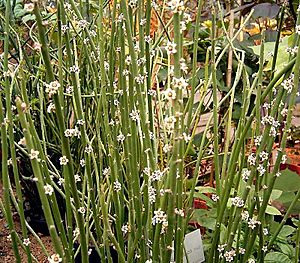Candelilla facts for kids
Quick facts for kids Candelilla |
|
|---|---|
 |
|
| Scientific classification | |
| Genus: |
Euphorbia
|
| Species: |
antisyphilitica
|
| Synonyms | |
|
Euphorbia cerifera Alcocer |
|
Euphorbia antisyphilitica is a cool plant often called candelilla or wax plant. It's a type of flowering plant in the spurge family. You can find it growing naturally in parts of Texas and New Mexico in the United States. It also grows in several states in Mexico, like Chihuahua and Coahuila.
This plant looks like a small shrub. It has many stems that grow close together and stand upright. These stems have very few leaves. They are covered in a special wax. This wax helps the plant save water by stopping it from evaporating, a process called transpiration.
What Candelilla Wax Is Used For
Long ago, people in Mexico used the white sap from E. antisyphilitica to help with certain health problems.
Around the early 1900s, people started collecting candelilla wax to sell. The need for this wax grew a lot during World War I and World War II. But after World War II, the industry slowed down. This was because there wasn't as much candelilla available. Also, cheaper waxes made from petroleum became easy to find.
However, new uses for the wax were discovered later on. Today, it's mainly used in makeup and food products. Candelilla wax is still made in northern Mexico and sent to other countries. Because so much of its wax is traded internationally, E. antisyphilitica is listed under Appendix II of CITES. This means its trade is carefully watched to make sure the plant is not over-harvested.
Growing Candelilla Plants
Candelilla is becoming a popular plant for gardens in dry areas, especially in the southwestern United States. People like it for several reasons:
- Once it's settled, it doesn't need much water. Rain is often enough, even in cities like Phoenix or Tucson. This makes it great for planting along roads.
- It can grow well in places that get a lot of reflected light.
- It grows best in soil that drains water easily. But it can also handle some clay or limestone in the soil.
- Butterflies visit this plant, even though it's not usually called a "butterfly plant."
- It can handle cold temperatures down to about 15 degrees Fahrenheit (around -9 degrees Celsius).
- It doesn't seem to have many problems with pests.
- You can also grow it in pots or containers.
See also
 In Spanish: Euphorbia antisyphilitica para niños
In Spanish: Euphorbia antisyphilitica para niños

